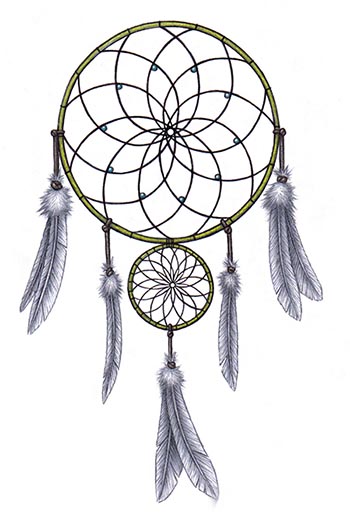The Ojibwe people have an ancient legend about the origin of the Dreamcatcher. Storytellers speak of the Spider Woman, known as Asibikaashi; she took care of the children and the people on the land. Eventually, the Ojibwe Nation spread to the corners of North America and it became difficult for Asibikaashi to reach all the children. The Ojibwe people, often referred to by their anglicized name, 'Chippewa', so insightfully understood the importance of dreams, especially in children, that they attempted to assist a child's ability to receive good dreams and filter out dark or negative dreams with the use of a dream catcher. The woven dream catchers of adults do not use feathers. Dream catchers made of willow and sinew are for children, and they are not meant to last. Eventually the willow dries out and the tension of the sinew collapses the dream catcher. That's supposed to happen. It belies the temporary-ness of youth. Adults should use dream catchers of woven fiber which is made up. Handcrafted by Northern Minnesota White Earth Ojibwe Indians (the original makers of a DreamCatcher), is this hand carved Turtle Shell Dream Catcher. One of a kind, Authentic and guaranteed to be original. Small measures about 5″ x 4″, not counting the fringe or hanger, Large is about 8″ x 6″, not counting the fringe. The dream catcher is considered to be a traditional Native American item that originated from the Ojibwe (Chippewa) tribe. For those who do not know, the Ojibwe tribe is from Minnesota, like me! The original version of the dream catcher was not always as fancy and elaborate as they are today.
What do dreamcatchers do? Purpose & Meaning of the Dream Catcher
Sometimes referred to as 'Sacred Hoops,' Ojibwe dreamcatchers were traditionally used as talismans to protect sleeping people, usually children, from bad dreams and nightmares. Native Americans believe that the night air is filled with dreams, both good and bad. When hung above the bed in a place where the morning sunlight can hit it, the dream catcher attracts and catches all sorts of dreams and thoughts into its webs. Good dreams pass through and gently slide down the feathers to comfort the sleeper below. Bad dreams, however, are caught up in its protective net and destroyed, burned up in the light of day.
Dreamcatcher Meaning: Web, Feathers & Beads
Authentic Ojibwe Dream Catcher
All parts of the authentic Native American dreamcatcher have meaning tied to the natural world. The shape of the dreamcatcher is a circle because it represents the circle of life and how forces like the sun and moon travel each day and night across the sky. Real casino application. The dreamcatcher web catches the bad dreams during the night and dispose of them when the day comes. As for the good dreams, the feathers act as a fluffy, pillow-like ladder that allows them to gently descend upon the sleeping person undisturbed. There is some contention when it comes to the meaning of the beads that often decorate the dreamcatcher. According to some American Indians, the beads symbolize the spider—the web weaver itself. Others believe the beads symbolize the good dreams that could not pass through the web, immortalized in the form of sacred charms.
Not a Indian produced goods as referred to by US Code Title 25, Sec 305 and seq. Zynga poker holdem on facebook vegas world.
Question: 'Is it wrong for a Christian to have a dream catcher?'Answer:


Essentially, a dream catcher is intended to manipulate the spirit world. Some people believe in the efficacy of dream catchers. Others are unsure but are superstitious enough to keep one in the bedroom. Still others see dream catchers as part of a cultural history or a piece of art that looks good dangling from a rear-view mirror.

Knowing the background of dream catchers and their talisman-like use, many Christians want nothing to do with them. Is such concern warranted? A passage in 1 Corinthians 8 may be helpful. Paul is speaking to Christians living in an extremely pagan culture ruled by superstition, magic, and sacrifices, all done in the name of various idols. The sacrifices were a particular concern, for the meat sacrificed was then sold at market. Some Christians felt eating sacrificed meat was endorsing the sacrifice and therefore inappropriate for a Christian; others believed that, since they were not worshiping the idol themselves, it was not wrong.

Essentially, a dream catcher is intended to manipulate the spirit world. Some people believe in the efficacy of dream catchers. Others are unsure but are superstitious enough to keep one in the bedroom. Still others see dream catchers as part of a cultural history or a piece of art that looks good dangling from a rear-view mirror.
Knowing the background of dream catchers and their talisman-like use, many Christians want nothing to do with them. Is such concern warranted? A passage in 1 Corinthians 8 may be helpful. Paul is speaking to Christians living in an extremely pagan culture ruled by superstition, magic, and sacrifices, all done in the name of various idols. The sacrifices were a particular concern, for the meat sacrificed was then sold at market. Some Christians felt eating sacrificed meat was endorsing the sacrifice and therefore inappropriate for a Christian; others believed that, since they were not worshiping the idol themselves, it was not wrong.
Authentic Ojibwe Dream Catcher History
Paul's guidance was this: 'There may be so-called gods in heaven or on earth—as indeed there are many 'gods' and many 'lords'—yet for us there is one God. . . . However, not all possess this knowledge. But some, through former association with idols, eat food as really offered to an idol, and their conscience, being weak, is defiled' (1 Corinthians 8:5–7). Ultimately, 'food will not commend us to God. We are no worse off if we do not eat, and no better off if we do,' yet we must be careful 'that this right of yours does not somehow become a stumbling block to the weak' (1 Corinthians 8:8, 9). Just as it was with meat associated with idolatry in the 1st century, so it is with superstitious objects in the 21st.The Christian understands that false gods are nothing and that a dream catcher has no power in itself. The believer in Christ could easily see a dream catcher as nothing more than a craft or a cultural expression. However, before he buys a dream catcher and hangs it in the window, he should consider other people's reactions to it. Will others see it as a charm to manipulate the spirit world? Will someone assume the one in possession of a dream catcher approves of Indian religions? Keeping a dream catcher is a matter of conscience; as long as it is not used as a good luck charm, it is innocent enough. But consideration must be given to those we seek to minister to.

